Shooting exercises for beginner marksman

For many new and experienced shooters, practicing with your firearms means shooting quietly at stationary targets at varying distances across the range.
It's definitely a useful way to learn to shoot more accurately, but if you want to push yourself and become an expert shooter, this is just the starting point.
At some point, you've probably heard the phrase "train like you're fighting." It is a precious mantra for living; you'll want to do your best to prepare for the specific types of situations you expect to encounter.
In this guide, we'll cover nine difficult (but not too difficult) marksmanship drills for beginning snipers - three each for pistols, shotguns, and rifles. We will also cover compensating malfunctions for each type of firearm.
Most of these exercises can and should be done while standing, kneeling, and lying down. Take them slowly and easily at first. Don't rush your shots or worry about rolling onto your back until you're comfortable and confident doing these drills in more natural positions.
Switch to timed versions of these drills only when you can hit the target consistently and safely without time pressure. Speed follows skill; slow is smooth, smooth is fast.
Pistol drills
Before trying any of these exercises, be sure to familiarize yourself with the parts and functions of your handgun .
All of these pistol drills can be done with a semi-automatic or a revolver, but for simplicity we'll assume you're using a semi-automatic. If you are using a revolver, replace "rapid loaders" with "loaders" and make other substitutions as appropriate.
5x5 precision drill
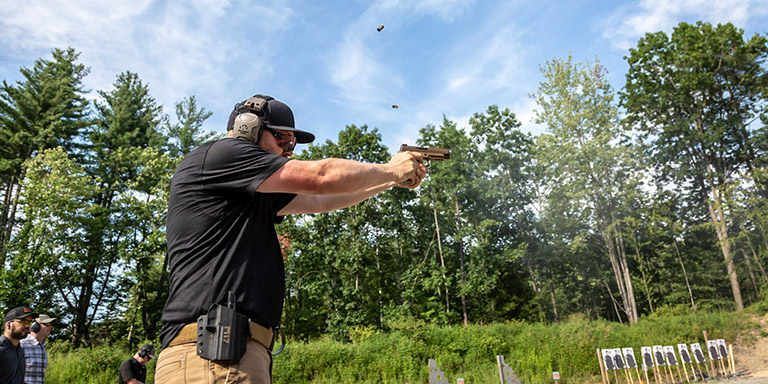
For this exercise, you will need an 8.5" x 11" (or larger) sheet of paper. On this, print twenty-five 1" circles spaced ½" apart in a 5x5 grid, or draw them by tracing a quarter with a marker. Mount the target 3 meters and load two magazines with five rounds each.
-
Load a five-round magazine and start in the low ready or compressed ready position.
-
Aim and fire two shots at the center of the first circle (top left). Fire slowly and carefully.
-
Move to the next circle in the row and shoot two more times.
-
Fire your last shot at the third circle, reload and fire once more.
-
Fire two more shots each at the fourth and fifth circles in the top row.
-
Reload your magazines and repeat the sequence for the remaining four rows. Try aiming, shooting, and reloading slightly faster in each subsequent row, but don't time yourself yet or sacrifice accuracy for speed.
-
Shots must be completely inside the 1" circles to count as hits.
-
When you can hit all fifty shots consistently at 3 yards, move the target back 4 yards, then 5, and so on and so forth.
Mozambican drill in case with emergency refills
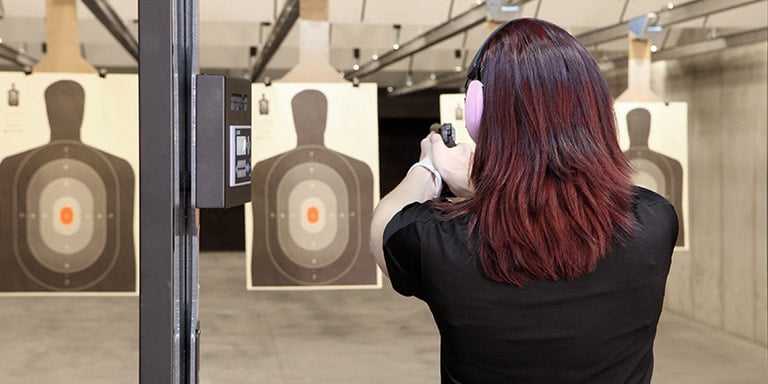
For this exercise, any target with a vaguely humanoid silhouette will do. Start at a distance of 5 meters.
-
Randomly load four different magazines with two to four rounds each. When you're done, shuffle them in such a way that you can't tell which is which, or have a partner load them up and shuffle them for you. Load a magazine at random, chamber a round, sheath your weapon, and stow the other three in your belt or on the bench in front of you.
-
When ready, fire and fire two shots at the target's chest area, then pause briefly and fire a third shot at the head. If you run empty before firing all three shots, do an emergency reload and fire the remaining shots. Do not anticipate reloads; focus on maintaining good two-handed shooting fundamentals until the potential need to reload becomes a real need.
-
Use extreme caution when performing live fire case drills. If you have little or no experience in drawing and rapidly firing a loaded weapon, do it at first with exaggerated slowness. Maintain excellent triggering discipline and excellent muzzle awareness throughout the pulling motion until you are fully extended and ready to fire. Only worry about drawing and pulling quickly after many safe and successful repetitions at slow speeds.
-
When you can fire and quickly fire two rounds to the chest and one to the head, reloading quickly if necessary, then move the target further and/or switch to timed drills.
Partner Assisted Multi-Target Drilling with Refills

For this exercise, place five human silhouette targets at different distances from 3 to 10 meters, in a cone of approximately 90 degrees. Number each target sequentially from left to right (for advanced versions of this exercise, mix up the numbers).
-
Randomly load four different magazines with two to six rounds each. Load exactly fifteen rounds between the four magazines. When you're done, shuffle them in such a way that you can't tell which is which, or have your partner load them up and shuffle them for you. Load a magazine at random, chamber a round, sheath your weapon, and stow the other three in your belt or on the bench in front of you.
-
Wait for your partner to call a number. Shoot and fire two shots to the chest of the corresponding target, then one to the head. If you run empty before firing all three shots, do an emergency reload and fire the remaining shots. Do not anticipate reloads; focus on maintaining good two-handed shooting fundamentals until the potential need to reload becomes a real need.
-
Use extreme caution when performing live fire case drills. If you have little or no experience in drawing and rapidly firing a loaded weapon, do it at first with exaggerated slowness. Maintain excellent triggering discipline and excellent muzzle awareness throughout the pulling motion until you are fully extended and ready to fire. Only worry about drawing and pulling quickly after many safe and successful repetitions at slow speeds.
-
Once you have fired the final shot at the target's head, your partner will call a different number. Engage that target the same way, reloading if necessary. Do not sheath your weapon between targets.
-
If your partner calls "reload" between targeted engagements, perform an emergency reload if your current magazine is empty. Perform a tactical reload (keep the partially used magazine) if there are rounds left in your current magazine.
-
The drill ends successfully once you have fired all fifteen shots, three on each of five targets, with ten hits to the body and five clear hits to the head.
-
For advanced versions of this drill, vary the number and position of targets, vary the number of rounds in each magazine, and/or race against the clock.
shotgun drills
Before attempting any of these exercises, be sure to familiarize yourself with the parts and functions of your shotgun .
Without a doubt, fast and accurate loading of a tube magazine is the hardest part of mastering shotguns. Because charging individual cases is much slower than replacing a charger, you'll want to master techniques that minimize downtime. And because shotguns are by far the most common, these drills will assume you're using one.
Weak and strong loading

You can load shells with your strong hand (trigger) or your weak hand (non-trigger). Each has its advantages and disadvantages.
Loading with a strong hand Loading with a strong hand is often faster and easier at first, especially for those who don't have much strength in their hands and wrists.
For shotguns with a stock, adopt a traditional shooting stance. With your weak hand, rotate the shotgun 90 degrees and lay the stock flat on your shoulder on the strong side so the ejection port is facing you. Support it with your weak hand on the front grip and use your strong hand to load the cartridges into the tube, one at a time. Practice regularly until you can charge quickly and reliably.
Loading with a Weak Hand Loading with a weak hand is more difficult, but can further reduce downtime once you get the hang of it.
From a normal shooting position, move the stock slightly lower on your shoulder or tuck it under your strong arm for extra support. Load shells with your weak hand without further altering your firing stance or shooting grip except to move your finger away from the trigger.
Once you get faster at charging weak and strong hands, practice switching between them. Situations may arise where one method or the other is not desirable, so it helps to be comfortable with both.
Loading "Open and close"
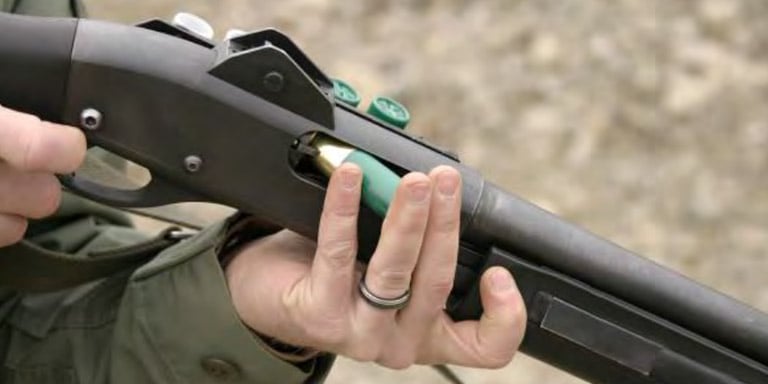
The "open and close" (or "combat loading") loading method is another slightly more advanced reloading method to minimize the time you spend being unable to fire your shotgun.
-
Using Snap Caps or dummy shells, load a single shell into the chamber and close it. Get into firing position and retract the front grip to eject the shell you just loaded as if you had fired it. Rather than finishing the pump, leave the front handle retracted and the latch open.
-
Release your grip on the shotgun with your supporting hand, but do not change your grip with your shooting hand in any way, except to move your finger away from the trigger.
-
If the shotgun has a stock, you can slide it under your strong arm if it's hard to support the full weight of the gun with your wrist.
-
With your weak hand, grasp a single seashell and hold it in your palm, perpendicular to your fingers, with the brass neck toward your little finger. Bend your fingers slightly to hold the case in place.
-
In one motion and without moving your weak hand in front of the muzzle, bring it under the loading port and gently "slam" the shell directly into the open ejection port.
-
Continuing the same smooth motion, move your weak hand to the front grip and press it firmly forward, chambering the shell.
-
From there, load the shells into the tube with your weak hand as usual. The weapon is ready to fire if you need to interrupt your reload.
-
Once you can do it smoothly and quickly, practice on the range with live ammunition.
Double and quadruple loading
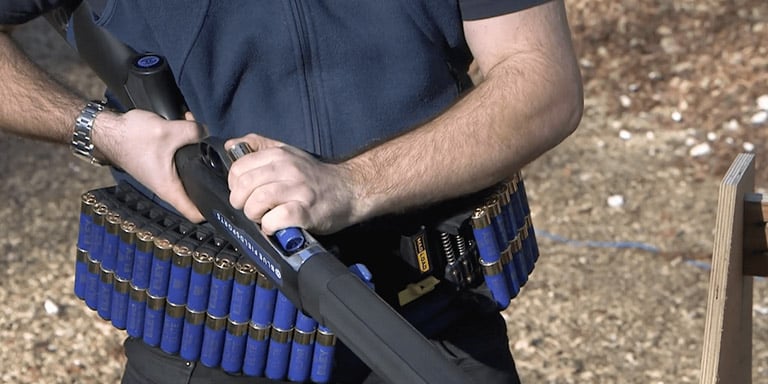
Mastering these techniques takes a lot of practice but will greatly increase your loading speed. Both will be much easier if you buy specialized four-load cartridge holders. Once you master the basic technique of using supports, you'll find it much easier to do this with loose shells.
-
For shotguns with a stock, adopt a traditional shooting stance. With your weak hand, rotate the shotgun 90 degrees and lay the stock flat on your shoulder on the strong side so the ejection port is facing you. Support it with your weak hand on the front handle.
-
Instead of grabbing a single shell, use your strong hand to pick up two shells stacked "on top" of each other, with the crimp of one pressed firmly against the primer of the other. Cover the exposed primer with your thumb and allow the exposed crimp to protrude from your hand 1-2".
-
Insert the exposed crimp into the charging port at an angle of approximately 30 degrees, slightly unrolling your fingers as the riser deflects.
-
Once the first shell begins to enter the tube, fully open your hand and push firmly with your thumb, sliding both shells into the tube in one motion.
-
When you feel ready, practice "quad-loading" by holding four shells in your strong hand, stacked in pairs. Load the pair closest to the heel of your hand first while firmly holding the other two between your folded fingers, then load the second pair as described in steps 3 and 4 above.
-
It takes a lot of practice for double and quadruple loading to start feeling smooth and comfortable. Do not be discouraged !
rifle drills
Before trying any of these exercises, be sure to familiarize yourself with the parts and functions of your rifle .
These drills assume you are using a semi-automatic rifle, but can be easily adapted to bolt-action rifles as well.
100 point drill
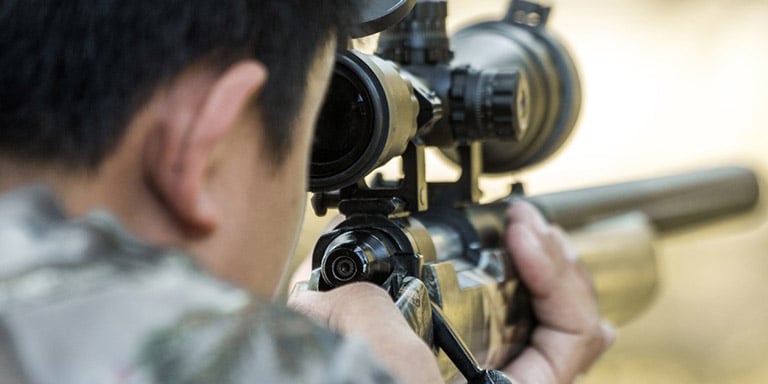
Set up ten 2" circular targets 50 yards away and adopt an unsupported prone position on the line of fire.
-
Focus on the basics of marksmanship - breathing, sight picture, grip, trigger pull and tracking. Fire one shot at each of the ten targets. Each shot is worth ten points and the objective is to score 100 points in one minute. Subtract ten points for each miss and one point for each second over sixty.
-
Once you can reliably complete this drill without missing, move the targets to 100 yards, then 150, etc. You can also use the same scoring system with increasingly shorter timeframes.
100 Point Drill Variant
Once you've mastered the 100-point drill above, set up three 5.5" circular targets, one at 100, 200, and 300 yards. Although this may appear to be essentially the same drill as the one above, this is significantly more difficult, as you will have to manually adjust the drop of bullets at vastly different distances.
-
Fire one shot at the 100 yard target, two at the 200 yard target, three at the 300 yard target, and finally four shots at the 100 yard target. Each free kick is worth ten points and the objective is to score 100 points in thirty seconds. Subtract ten points for each miss and one point for each second over sixty.
-
When you can land all ten shots without missing in the time limit, vary the range of each target and/or gradually shorten the time limit.
Random Magazine exercises
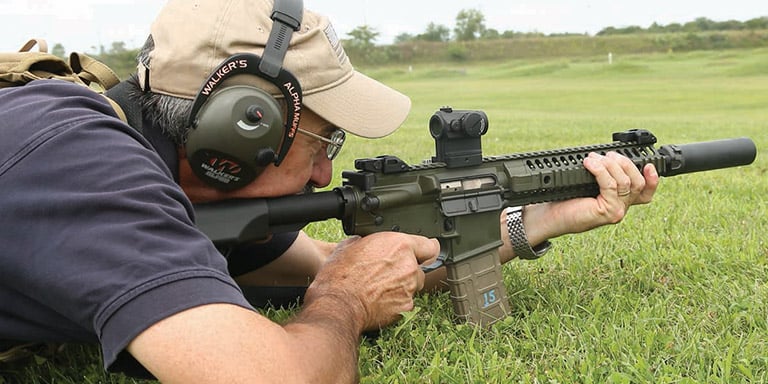
When you've become good at both versions of the 100-point exercise above, take it to the next level by splitting your allotted ten rounds between three magazines.
Better yet, have a partner load a random number of rounds into each magazine without telling you how many are in each (the total should always be ten).
Complete drills at 100 points within their time limit while reloading each time you empty a magazine. This forces you to periodically break your aim picture and quickly reacquire the target after reloading, which is especially difficult when the targets are at different ranges.
Troubleshooting Pistols and Rifles

For this exercise, you will be using Snap Caps, not live ammunition. Remove all live ammunition from the practice area and have a partner verify that every cartridge you use is a dummy cartridge.
This exercise does not apply to revolvers or bolt-action rifles. For semi-automatic rifles, replace occurrences of "slide" with "bolt".
Tap, Rack, Bang
Practice “tap, rack, bang,” the standard and most common method for eliminating magazine-fed firearm malfunctions. If your gun doesn't fire when you expect it to, "push, push, knock" before trying to diagnose the problem. This method eliminates most malfunctions and should become an immediate, instinctive response when your gun won't fire. You should only stop to investigate the malfunction when "push, push, slam" fails to fix the problem.
-
Press up on the magazine to make sure it is securely in place.
-
Engage the slide (or retract the bolt) firmly and decisively.
-
Attempt to shoot.
SPORTS
For rifles with forward assist mechanisms, use the acronym SPORTS.
-
Turn up on the charger to make sure it is securely in place.
-
PULL the bolt backwards.
-
Observe the chamber to make sure it is now empty.
-
Release bolt.
-
Press on the front assist.
-
Press the trigger (the weapon should now fire).
Stovepipes
Simulate a "stovepipe" malfunction by ejecting the magazine, manually loading a cartridge into the chamber, and placing an empty case or cartridge in the ejection port so that it partially protrudes. Then release the slide and reinsert the magazine. The partially ejected cartridge will prevent the slide/bolt from closing.
To remedy this malfunction, bring your support hand towards the ejection port but do not pass it in front of the mouth. With a flat hand, sharply sweep the jammed case out of the ejection port in a backward motion. Push the slide forward into the battery or charge the bolt if necessary, then attempt to fire.
NOTICED : Do not pull the slide back in response to a stovepipe malfunction. This is likely to cause a double feed, which takes even longer to clear.
Dual feed
Simulate a double feed by locking the slide back, placing a cartridge in the chamber, inserting a loaded magazine and releasing the slide. It will jam when trying to load a round into the already loaded breech.
This type of malfunction occurs when a pistol or semi-automatic rifle fails to extract and eject an empty case, after which the next cartridge cannot be loaded because the case remains in the barrel. "Lock, Drop, Rack, Watch, Load, Rack" to clear this malfunction.
-
Lock the slide back.
-
Remove (and keep) the charger.
-
Rack the slide twice, firmly and decisively. One, maybe two rounds should be ejected.
-
Look at the chamber while holding the blade open to make sure it's empty.
-
Load the store.
-
Slide the slide and try to shoot.
Removed shotgun malfunctions
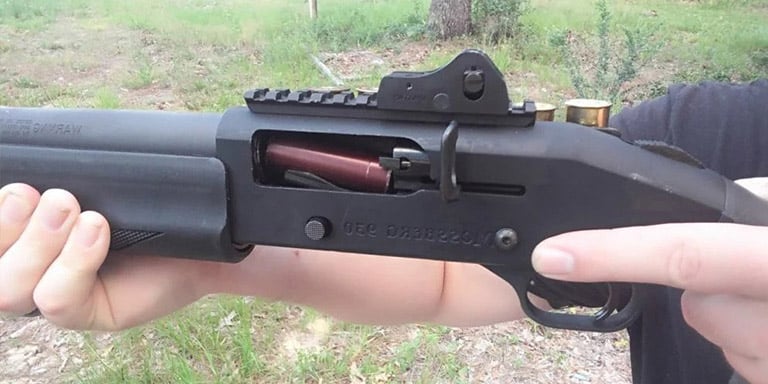
The three basic types of shotgun malfunctions (ejection failure, stovepipe, and extraction failure) are roughly analogous to the two most common types of pistol and rifle malfunctions, but the methods for repair are somewhat different.
Ejection failure
The most common type of shotgun malfunction is, fortunately, the easiest to repair. If an empty shell is successfully extracted from the chamber but does not eject from the loading port, it is likely because you have "cut short" the pump (i.e. you don't have moved the forearm fully backward with sufficient force).
To solve this problem, simply tilt the ejection port towards the ground and drop the empty shell. Never be afraid to work the action hard - the gun can take it!
Stovepipe
This problem is solved essentially the same way as for pistols and rifles. Open the action fully, then flatten your supporting hand and sweep it quickly and firmly along the bottom of the weapon and through the ejection port. This should be enough to dislodge the stuck shell. Then close the action and resume shooting.
Extraction fault
This is the least common shotgun malfunction, but it is also the most serious. If there's a shell stuck in the chamber that won't dislodge when you try to work the action, it will take several seconds and some brute force to get it out.
Try pushing the pump forward first, then back as hard as you can. This gives the puller another chance to grab the stuck shell and pull it out properly.
If that doesn't work, perform the next step very carefully. Squeeze the trigger with your weak hand and hit the butt hard against the ground while simultaneously pulling the handle back with your strong hand.
Never practice this with live ammunition, as the barrel will be pointed skyward (make sure to put it as far away from your face as possible). Use this technique with live ammo only in life or death situations where you need your shotgun back in action as quickly as possible.
To repair a failed extraction on the range, lay the gun on the bench with the muzzle pointing down and carefully use pliers to extract the stuck shell.
It is practice makes perfect
Although some of these exercises may seem too advanced to qualify as a beginner's level, most of them are technically not particularly difficult.
Even the more tricky ones, like shotgun quick-loading drills, are great for beginners because the problems they're designed to overcome are the ones most likely to frustrate (or even endanger) players. novice shooters.
0 comments
